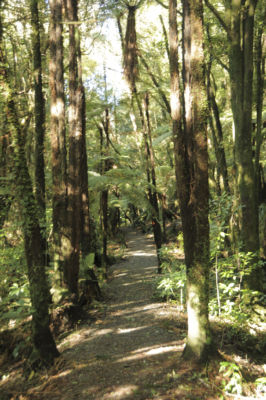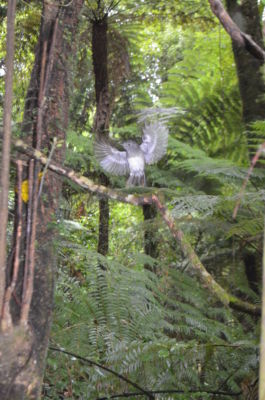Puketoki Reserve is virgin low-altitude podocarp forest in the Whakamarama area (between Katikati and Tauranga). It was set aside for the people of the Tauranga region in 1928, by sawmilling firm Sharplin Brothers in a very early example of business conservation ethic. In recent times, the 40 Ha of virgin bush had become a haven for rats and possums.
The understory was badly chewed, there was little regeneration and only one pair of North Island Robins were thought to be struggling on. The forest had gone quiet. “There had been no pest control for years,” says Colin Hewens.

Terry Edwards got together a volunteer pest control group at the popular walkway about 11 years ago. Colin was a part of Terry’s original group, and has handled PR and records for the “Friends of Puketoki” – a core team of nine, along with two or three others who help out when needed.
Rats were seen as the biggest problem initially. After the first year of setting rat bait, there was little sign of rats. Yet the rat bait was still being removed…
The answer to the mystery turned out to be possums. They were reaching into the bait stations and happily eating the bait. Toxin levels in the rat bait were too low to harm them and the Puketoki possums were getting fat on free snacks.
The Friends called in some expert help from Wild About NZ, a local based environmental organisation, who got Auckland firm Connovation Ltd involved, and soon they were dealing to the problem possums too. Now they have 60 Connovation Warrior possum traps set up, along with 80 bait stations of rodent anticoagulant poison in the 40 Ha reserve.
“It’s probably the most heavily trapped reserve in the country,” says Colin.
The effort is paying off.
“When we started trapping we were getting about 35 possums per month for the first two or three months,” Colin says. “Then it went down to about 100 in the second year, and then about 50 per year. Now we get only about 20-25 per year, mostly young invaders coming into the area.”
“In March/April there is an influx of juvenile possums as the youngsters get kicked out of their parents’ territory. We get 12-15 in two months, then the odd adult during the rest of the year.”

“There’s been a great burst in birdlife,” says Colin. “There was only one pair of North Island robins originally. In a recent 5-minute bird count there were 12 robins counted. There are probably about 30 robins all told. You always see them, quite close. They’re fearless.”
The forest itself is visibly benefitting, too.
“Seeds are germinating, the undergrowth isn’t eaten, many users comment on the healthy bush.”
An insect survey was done shortly after the volunteers started trapping. Back then weta had a 13% presence.
“Weta have increased to a 90-95% presence in 10 -11 years,” says Colin. “It’s a great indicator of biodiversity improvement.”
Local Periodic Detention workers help with gravelling tracks. The Friends of Puketoki once got them to help with trimming the tracks as well. Puketoki Reserve has 40 and 20 minute walking tracks, which are both highly used. The workers were just a little too enthusiastic with their pruning, so Colin and the other Friends prefer to do that task themselves these days.
Predator control takes up most of their time, however – about 90% of their work at Puketoki is connected to checking traps and bait stations. The Reserve is bordered by farmland and lifestyle blocks. Rats are constant invaders, and bait is constantly taken.

The work at Puketoki is ongoing, but essentially under control, so Colin’s interest has now shifted to the challenge of tackling a new pest free project, using the experience and knowledge gained in Puketoki. It’s around an old log-out area known as ‘The Blade’, at the very end of Whakamarama Road, in the Kaimai Mamaku State Forest Park.
The Blade is named for the bulldozer blade that sat there abandoned for many years, until scavengers unknown removed it, probably selling it for scrap. The name stuck, however, and the bladeless ‘Blade’ was adopted two or three years ago by Whakamarama Community Inc., who have started developing a loop walkway there. The volunteer predator control group will work under the recreation group of Whakamarama Community Inc. to surround this track.
“It had a nice bit of recovering bush and deserved a nice loop walkway for general public access,” says Colin.
At The Blade there is 90 Ha of recovering cutover native forest, including two botanically interesting wetlands about 300-400m above sea level. The wetlands are in hollow areas and attract frosts. Local botanists were surprised to find wetland plants growing there that are normally only found in higher altitude wetlands.
Unlike the situation at Puketoki 10-12 years ago, The Blade still has fairly good birdlife with rarely heard fernbirds, tomtits, and whiteheads as well as many North Island robins, tui and bellbirds.
“It can only get better,” says Colin.
The other thing that makes the area interesting to the new group Friends of the Blade, is that the forest is part of the larger Kaimai Mamaku State Forest Park. In the longer term there is the potential to spread out the predator control work into a much larger area.
The Blade project is still gearing up. A 40-minute walkway is about ¾ done, but still needs a couple of bridges – and all the paperwork and permits that bridge-building entails. For the pest control, a series of articles in local newspapers generated an initial rush of over 30 volunteers, but paperwork like grant applications and permits can take a lot of time and Colin fears some of those volunteers may have lost interest in the interim.
In 2015 the Western Bay of Plenty District Council awarded a community grant to set up eight trap lines, which have been cut by a group known as the Mahi Boys, run by Paul Mason, under DHB auspices. They also put in the 40-minute walkway.
“The trap lines were a lot of work to cut,” says Colin.
Lately ten Friends of the Blade volunteers have been regularly involved on the Blade lines every two weeks. The Bay of Plenty Regional Council has allocated an EEF of nearly $9,000 for traps, baits and infrastructure. Possum traps will be set up on a 150m x 150m grid and rat bait stations in the trees away from pig interference, on a 75m x 75m grid. Once they are all in, there will be a need for more volunteers to become involved.

